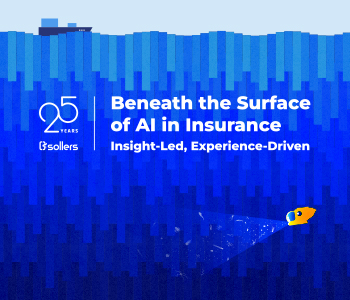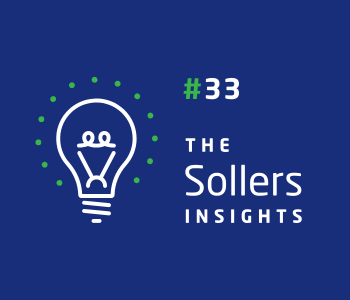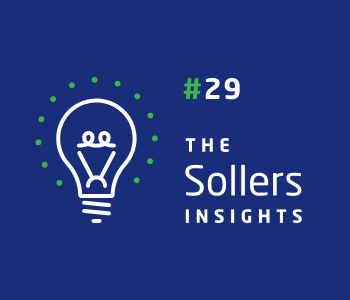
By Piotr Kondratowicz
The insurance industry has made a clear shift from exploring artificial intelligence (AI) to actively investing in it. Nearly every insurer has trialled AI in some form – whether through document recognition, chatbots, or analytics – but only around half have formally embedded AI into their broader strategic agendas. According to the latest Sollers AI Report, on average 51% of insurers have AI as part of their strategic planning, indicating a move from experimentation toward structured implementation.
While adoption is increasing, the gap between experimentation and scaled impact remains substantial. One of the key factors is legacy infrastructure. Many insurers still rely on outdated systems and manual processes, which hinder efforts to automate core functions. These challenges vary across business lines, but the reason is the same: AI cannot create lasting value without addressing foundational issues in data and operations.
Fixing the foundation
One of the biggest barriers to effective AI adoption in insurance is data quality. While poor or unstructured data has long been seen as an obstacle – especially for predictive analytics – today’s reality is more complex. Insurers face multiple challenges: legacy systems that produce paper documents or operate on scanned images instead of structured data, fragmented databases, and a lack of integrated workflow tools for end-to-end process management. Historically, key data could even go unrecorded – because processing was done manually and business logic or parameters of each case did not leave digital trace in data. It could remain in the employee’s head, in a paper form or just as a vague text in a descriptive field (which is not structured data).
Yet the landscape is shifting. AI now can transform unstructured, externally received documents into structured data, removing reliance on manual entry and unlocking automation. But data alone isn’t enough. True transformation requires redesigning the entire data architecture – supported by modern data platforms, digital workflows, human-in-the-loop (HITL) interfaces, and automated business logic. Critically, this doesn’t mean centralising all data. Approaches like data mesh enable decentralised, step-by-step integration – vital for processes like claims, where automation hinges on well-structured policy data. Business rules, workflow engines, and smarter system design must converge to drive this evolution. Without these foundational changes, AI cannot effectively enable intelligent, large-scale decision-making.
Leading organisations are tackling this step-by-step, often beginning with specific product lines or regions where data is more manageable. The result is a gradual, focused improvement in the quality and availability of data – a necessary step towards making AI work at scale. In fact, the Sollers AI Report identifies document and email data extraction as the top automation priority, with 69% of insurers using AI in this area – highlighting just how foundational structured data has become. With increasing structured data volumes, the systematic data governance and proper data tools are becoming increasingly important.
Artificial Intelligence in Insurance
Take the next step in process automation
and improving customer experience
Learning through phased implementation
Despite the rapid development of AI capabilities, full automation of key insurance processes remains a long-term goal. Depending on operational complexity and internal readiness, the timeline for most insurers is estimated to be between 5 and 10+ years.
In the short term (1 to 3 years), the focus is on automating claims handling using document recognition and large language models (LLMs) to assist experts. Claims handling is expected to deliver the greatest competitive impact of all AI applications across business areas, scoring 3.4 in the Sollers AI Report. This reflects an estimated significant impact, based on a scale where 1 indicates minimal and 5 indicates disruptive potential. It ranks ahead of customer experience (3.1) and far beyond new insurance offerings (2.3), underlining its strategic importance in future AI deployments.
Over the medium term (3 to 5 years), attention shifts to automating call centres and inspections. In the longer term (5 years and beyond), more complex areas such as underwriting and digital client interaction are expected to evolve – but only if the underlying digital infrastructure improves.
Governance-enabled steady progress
The growing popularity of generative AI and LLMs is accelerating interest in large-scale deployments. Yet speed without proper oversight can be risky. AI systems implemented without clear governance, ethical controls, and robust data management may do more harm than good.
To strike the right balance, many insurers are adopting “hub-and-spoke” operating models – combining central governance with decentralised experimentation and adoption. This structure allows business units to innovate while ensuring consistency in standards, quality, and regulatory compliance. This aligns with current trends described in the Sollers AI Report, as on average 54% of insurers now use or are planning a centralised governance model for their AI automation units, in contrary to on average 20% for the decentralized models.
SOLLERS AI REPORT
Beneath the Surface of AI in Insurance:
Insight-Led, Experience-Driven
SOLLERS AI REPORT
Beneath the Surface of AI in Insurance:
Insight-Led, Experience-Driven
The human touch still matters
AI is not here to replace jobs – it's here to assist people in working more intelligently. In mature markets like Germany, this support is becoming increasingly vital. Over the next decade, roughly 30% of the insurance workforce is expected to retire, while the number of young professionals entering the field may drop by 20%. At the same time, the labour market is evolving: more employees are looking for engaging, developmental roles rather than repetitive manual tasks. AI-driven automation supports this shift by enabling more meaningful work and freeing up capacity for higher-value activities. Without such productivity gains, insurers may struggle to meet both workforce expectations and customer demand.
Forward-looking insurers are responding by redefining roles rather than removing them. They are using AI to take on repetitive tasks, allowing employees to focus on complex decisions and customer engagement. Upskilling initiatives – such as pairing underwriters with data scientists to co-create AI-driven tools – are helping to bridge experience with innovation and build trust in the technology. LLMs, in particular, are gaining rapid adoption in this context – with 82% of insurers now using an LLM in at least one business area listed in Sollers AI Survey.
Three important factors to successful implementation
So, what’s the difference between insurers who are actually moving forward and those still stuck in endless pilot programs? Three factors consistently stand out, based on lessons learned from the Sollers AI Survey and our hands-on experience with insurers.
- Aligning AI initiatives with business goals. The most effective initiatives are closely tied to strategic priorities. Rather than deploying AI for its own sake, successful insurers focus on targeted, high-impact use cases where technology can solve meaningful problems and deliver measurable value.
- Building cross-functional collaboration.AI cannot sit solely within IT. Successful adoption depends on early and ongoing collaboration with business lines – including different areas like claims, underwriting, legal, and customer service. This creates a higher probability that AI solutions are aligned with real operational needs and integrated smoothly into daily workflows.
- Maintaining human oversight – but challenging old habits.Finding the right balance between automation and control is crucial. Often, the biggest hurdle isn’t technology, but trust. At a major European insurer fully automated systems were technically feasible, but teams hesitated to expand their use due to concerns over occasional errors – even when there were 90 correct outcomes for every one mistake. These rare issues were enough to cause resistance, particularly among those new to AI. The challenge isn’t just technical or procedural – it’s also psychological. People make errors too, but we’ve learned to manage that within our processes. The same needs to happen with AI: instead of expecting perfection, we must design systems that can effectively handle exceptions and help teams build trust in automation over time.
Making AI a natural part of how insurance works
The promise of AI in insurance is real – but achieving it takes more than cutting-edge models. It demands better data, strong governance of AI-driven transformation, redefining architecture, and above all, a cultural shift in how organisations think about technology and talent. The insurers that will lead in the years ahead are not necessarily those with the most advanced tools, but those that can embed AI into the way they operate, collaborate, and serve their customers. Today, 97% of Sollers AI Survey respondents are using at least one type of an AI tool. On average, each insurer has implemented or is in the process of implementing about 45% of the AI tool categories surveyed – indicating that adoption is not only widespread but increasingly embedded across a range of functions. Gradual, strategic, and people-centred transformation will make the difference between pilot projects and lasting impact.
Conclusion
AI adoption in insurance is moving from experimentation to structured implementation, but success depends on more than technology. Data quality, modern architecture, and strong governance are prerequisites for scaling. The biggest impact is expected in claims automation, supported by LLMs and process redesign.
Insurers that align AI with business goals, foster cross-functional collaboration, and maintain human oversight will move beyond pilots and achieve lasting value.
Authors of the article
 Piotr Kondratowicz - Business Architect at Sollers Consulting
Piotr Kondratowicz - Business Architect at Sollers Consulting
Technology & Market Insights



AI, CEO Voices
CEO Voices – Interview with Jean-Daniel Laffely, CEO of the Vaudoise Insurance Grou...







AI Automation, Data management, Process Automation
Data standardisation is the backbone of automation
